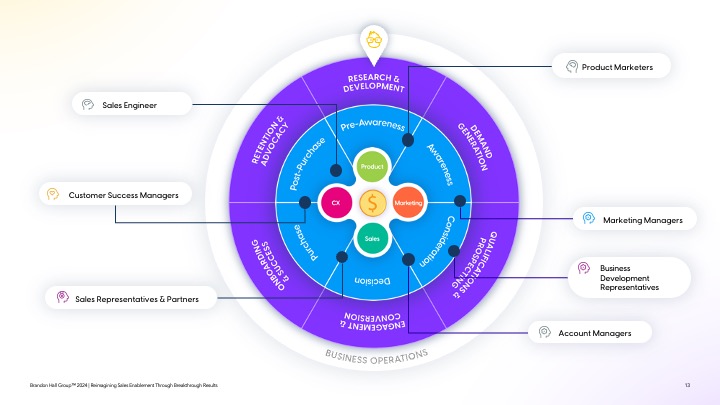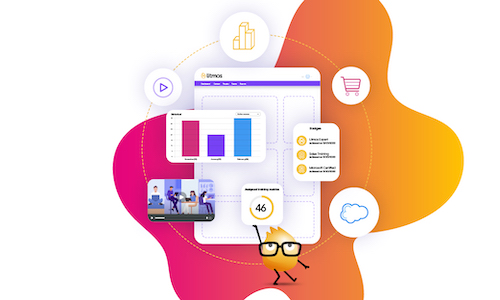Brandon Hall Group Roundtable Webinar Explores the Evolution of Sales Training and the Role of AI in Revenue Enablement
A recent virtual roundtable hosted by Brandon Hall Group™ titled, Rev Up Revenue: Reimagining Sales Enablement for Breakthrough Results Confirmation, focused on the evolution of sales and revenue training, the comparison of sales training and sales enablement, the differences between sales enablement and revenue enablement, how to drive revenue enablement, and the role of AI in revenue enablement.
The webinar’s panel of experts included:
- Jeff Griggs, Chief Revenue Officer at Litmos
- Chris Richards, Head of Corporate Development at Litmos
- Ted Martin, President and Chief Revenue Officer at Factor 8
- Steve Richard, Senior Vice President of Enablement at Mediafly
- Claude Werder, Principal Analyst at Brandon Hall Group
These industry experts shared their insights on sales and revenue enablement, as well as strategies that organizations can leverage to optimize their sales processes to drive revenue growth.
Revenue enablement vs. sales enablement
The webinar kicked off with a discussion about the importance of revenue enablement, and why it is a more comprehensive strategy than sales enablement. Instead of focusing solely on the sales team, the panelists argued, revenue enablement involves every department that contributes to generating revenue, from product development to customer success.
“Revenue enablement requires the whole organization to be swimming in the same direction to make it work,” said Chris Richards.
Jeff Griggs agreed and warned, “If you do not take the time and the energy to look at the buyer’s journey, and you do not take the time to document that, you miss out on that total alignment and continue down the silos.”
Ted Martin emphasized the importance of including frontline leaders in the revenue enablement process, stating, “Being that frontline leader is the most impactful position in business because you drive what is going to happen within your organization, at the rep level, at the front lines, in the reps, and in what they’re doing.”
Achieving successful revenue enablement requires alignment across all departments – not just customer-facing ones along the buyer’s journey. A cultural change that values continuous learning and a focus on measuring success is needed for any organization to see revenue enablement success. The panelists emphasized the need for a culture where everyone understands the value of enablement and learning.
Alignment, cultural change, and measurement for successful revenue enablement
Cultural change is an essential ingredient for revenue enablement success, according to Jeff Griggs. “You’ve got to start with culture change. If you’re not going to get buy-in from the organization and the people doing it, you’re going to unfortunately fail.” Agreeing, Steve Richard clarified exactly which levels of leadership need to buy into revenue enablement to ensure success, comparing an organization to a family unit:
“Individual contributors are the reps. Then you’ve got first level managers or first level leaders. They manage the reps. They have to be on board. I think of them as the parents enablement. We (senior leadership/executives) are the aunts and the uncles. We can’t hold anybody accountable. They don’t report to us. I would argue that you have to have the second level on board, too. I don’t see learning initiatives succeeding unless you have the second level on board.”
The panelists also highlighted the importance of measuring the return on investment (ROI) of enablement efforts, with Chris Richards noting that, “Those companies that actually measure ROI, have the feedback on what enablement did to change the organization, and that got everybody to buy in cross-functionally? That’s going to be huge.”
| Key quotes: |
|---|
| “If you don’t take anything away from this, if you go over to Steve’s house, do not walk on his countertops.” – Ted Martin |
| “The half-life of skills changes every two years.” – Jeff Griggs |
| “Every organization, one has an all-star rep, or two or three or four. Really look at them, try to dissect how they got to where they are in their career and how they found success and build your revenue enablement program around what’s made them successful.” – Chris Richards |
| “Start with the problem statement and what you’re trying to achieve first, then go after the AI that’s going to help you get there.” – Steve Richard |
The role of Artificial Intelligence (AI) in revenue enablement
AI can provide valuable data, help to automate administrative tasks, and offer personalized recommendations, all of which can significantly enhance revenue enablement. However, the panelists cautioned that companies should refine their approach to AI implementation, and first identify the problem that needs to be addressed before seeking an AI solution.
Ted Martin used a baseball analogy to explain how his team uses AI to narrow the focus of its sales strategy. The “Ted Williams strike zone approach” he uses helps his team leverage AI data to “determine what pitch you’re going to swing at 90 miles an hour down the middle of the plate, so that you bat over 400 versus chasing everything as a business. And the same thing applies to how you do that with AI and how you enable your team to go after the best things.”
Steve Richard also advocated for a more strategic approach to AI in sales. “Start with the problem statement and what you’re trying to achieve first,” he explained, “then go after the AI that’s going to help you get there.” Jeff Griggs agreed. “You’ve got to go out and identify that [problem]. Then you’ve got to go out and say, the value of that to the business is that we are going to be assigned to more projects; ‘We’re going to get more revenue and we’re going to be the most skilled people that go after those projects.’”
Chris Richards suggested that AI can help companies start small and prove the value of their enablement efforts: “Try to find a very small problem at your organization where you can [make] change and prove out the real ROI behind it, because that will build momentum behind you and allow you to break down those cultural barriers and get that message up to the top.”
| Insights surfaced: |
|---|
| – Sales enablement has evolved from just focusing on sales reps to including all customer-facing roles, including marketing |
| – Alignment across all departments is crucial for successful revenue enablement |
| – Frontline managers play a crucial role in driving revenue enablement initiatives |
| – AI can help in identifying patterns and trends, automating remedial tasks, and providing personalized recommendations for learning |
| – Organizations should identify which problems to address with AI before implementing AI solutions for revenue enablement |
| – Continuous sales onboarding is vital to combat the forgetting curve and keep sales reps updated with the latest skills and knowledge |
During the presentation, attendees gained valuable knowledge and practical tips on how to implement effective sales enablement and revenue enablement initiatives within their own organizations. The session was well-received by participants and sparked engaging discussions on the future of sales enablement and its impact on business success. To explore how your organization can rev up revenue through better enablement, watch the webinar today.





